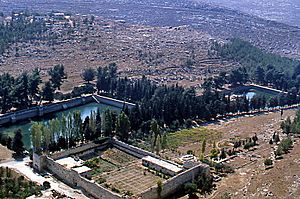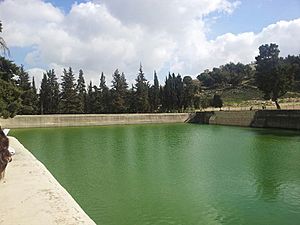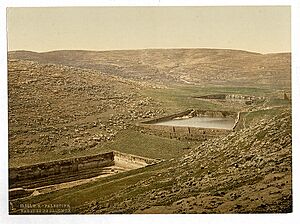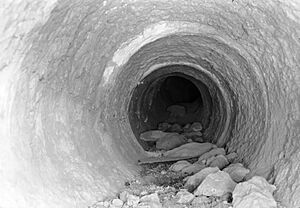Solomon's Pools facts for kids
Solomon's Pools (also called Burak Suleīmān in Arabic or Breichot Shlomo in Hebrew) are three very old water reservoirs. You can find them in the southern part of the West Bank. They are located near al-Khader, about 3.5 kilometers (2.2 miles) southwest of Bethlehem, close to the road that goes to Hebron. These pools are in an area called Area A of the West Bank, which is managed by the Palestinian National Authority.
In ancient times, Solomon's Pools supplied water to Jerusalem. They fed two large water channels called aqueducts during the Second Temple period. The first one, known as the "Low-level Aqueduct," was likely built around the end of the Hasmonean dynasty period, in the first century BCE. It carried water to underground storage tanks beneath the Temple Mount, mainly for the Second Temple. A second aqueduct, the "High-Level Aqueduct," followed a similar path. It might have supplied water to Herod's Palace. The pools also sent water to Herodium, an ancient fortress and palace.
Contents
Why They Are Called Solomon's Pools
Even though the pools are named after King Solomon, experts believe they were built much later. They are linked to a passage in the Book of Ecclesiastes (2.6) that says: "I made myself pools from which to water the forest of growing trees."
Josephus, an ancient historian, wrote that Solomon enjoyed the beautiful, water-rich place called "Etham." One of the main springs feeding the pools is still called Ein Eitam today. The pools are also close to an old town called ʻEiṭam. A popular story says that King Solomon built these pools for his many wives to bathe in. A French explorer named Victor Guérin visited the site in the late 1800s. He wrote about the pools and nearby villages in his book Description de la Palestine.
While tradition connects the pools to Solomon, the way one pool is built and a recently found aqueduct suggest they were made in the early Roman period. Josephus also mentioned that he would pass this place while riding in his chariot.
What the Pools Look Like
The Pools and Their Aqueducts
Solomon's Pools are made up of three big reservoirs. They are separated by several dozen meters, and each pool is about 6 meters (20 feet) lower than the one above it. They are shaped like rectangles or trapezoids. Parts of them were carved out of the rock, and other parts were built. They are between 118 and 179 meters (387–587 feet) long and 8 to 16 meters (26–52 feet) deep. Together, they can hold over 290,000 cubic meters (75 million US gallons) of water.
It is thought that Herod the Great or an earlier Hasmonean ruler built this complex system of pools and water channels. The original rectangular holes might have been stone quarries. The pools got their water from two aqueducts. They also collected water from several springs in the area, including one under the lowest pool. Rainwater from the hills also flowed into them.
The pools worked as a place to store and send out water. Two aqueducts brought water to the pools from the southern hills. The collected water was then sent out by two other aqueducts going north to Jerusalem. Another one went east to the Herodium. We can still find traces of all five of these aqueducts today.
The pools are built so that water from the highest pool can flow into the one below it. From there, water was pumped. An aqueduct first carried water to Bethlehem, then through an underground channel, and finally to the Temple Mount area in Jerusalem. The water dropped about 35 cm (14 inches) for every 270 meters (886 feet) from the pools to Bethlehem. From Bethlehem to Jerusalem, it dropped about 35 cm (14 inches) for every 1,700 meters (5,577 feet).
This aqueduct, often called the "Lower Aqueduct," crossed the Valley of Hinnom. It then continued along the southern slope of Mount Zion and entered the city near the Jewish Quarter. It ran along the eastern side of that hill, partly on stone structures and partly through a channel carved from rock. It eventually turned east and entered the Temple Mount courtyard near the Chain Gate.
Today, below the middle pool, you can see the remains of a pump station from the time of the British. This station used to pump water to the Old City of Jerusalem. Another, newer pumping station below the lowest pool still provides water to Bethlehem.
The Turkish Fort and Museum
Near the Upper Pool, there is a small Turkish fort called Qal'at el-Burak, or Qal'at Murad. It is now known as Murad or Burak Castle. This rectangular building has four square towers at its corners. The Ottoman sultan Osman II built it in 1618. It was used as a place for Turkish soldiers to live. They guarded Solomon's Pools and the trade routes between Jerusalem and Hebron. It was also a stop for people traveling on the hajj (pilgrimage) route to Mecca. For a long time, it was also used as a caravanserai, a roadside inn for travelers. After being left to decay since the mid-1800s, the ruined fort has been mostly rebuilt. It is now part of a new tourist area.
The Castle Museum inside the fort has one of the largest collections of Palestinian history and culture.
History of the Pools
How the Water System Grew
The water system grew over time. It included two aqueducts that brought water to the pools. The pools themselves stored and distributed the water. Then, three more aqueducts carried the water: two went north to Jerusalem, and a third went to Herodium. Together, these five aqueducts were about 80 kilometers (50 miles) long.
The Upper Pools
We are not sure exactly when the two upper (westernmost) pools were built. They were probably started during the Hasmonean dynasty period, between the mid-second and mid-first century BC. Herod the Great likely finished them as part of his rebuilding program for the Second Temple.
The Low-Level Aqueduct
The Low-Level Aqueduct was probably built in the first century BCE, near the end of the Hasmonean dynasty period. This aqueduct started at the lowest pool. After traveling to Jerusalem, it crossed a bridge over the Tyropoeon Valley to reach the Temple Mount platform. It ended inside the water tanks hidden underneath the Temple Mount. The water from this aqueduct was mainly used by the Second Temple.
Archaeologists found two small coins on the surface of this aqueduct. One was from Alexander Jannaeus and the other from Herod the Great. They also found a piece of a roof tile with a stamp from the Legio X Fretensis, a Roman legion.
The High-Level Aqueduct
The High-Level Aqueduct started at the upper pool and followed a path similar to the Low-Level Aqueduct. However, we don't know its exact destination in Jerusalem. Experts believe it might have supplied water to Herod's Palace. Ancient writings say that Herod's Palace was famous for its many water fountains.
The Wadi el-Byiar Aqueduct
Herod also built the clever Wadi el-Byiar Aqueduct. This aqueduct supplied water to the upper pool. Part of it was built as a tunnel that collected underground water from the aquifer it passed through. This helped to add to the spring water and surface runoff it was already carrying.
Pilate's Arrub Aqueduct
Later, a Roman prefect named Pontius Pilate built another aqueduct. It was about 39 kilometers (24 miles) long and brought even more water to Solomon's Pools from large collection pools at Arrub to the south. Pilate paid for this aqueduct using money from the Temple treasury. This action made the local people very upset. This aqueduct was destroyed during the First Jewish–Roman War.
The Mamluk Lower Pool
The lowest of the three pools was built in 1483 CE. This was during the time of the Mamluk Sultan Qaytbay. Between 1480 and 1484, a traveler named Felix Fabri visited the site. He wrote that near the middle pool there were "pavilions and tents" where the builders and workers lived. He also saw many "Moors and Saracens" (terms for Muslims at the time) working around these tents.
Later History
The water system based on Solomon's Pools supplied water to Jerusalem, on and off, for two thousand years. It continued to do so until 1967.
Major repairs to the water system were done by the 10th Roman Legion in the second century CE. Later, the Mamluks, the Ottomans, and the British also made repairs. For example, in 1902, a new 16-kilometer (10-mile) pipeline to Jerusalem was opened. This was to celebrate the 60th birthday of the Ottoman sultan Abdul Hamid II.
Springs That Feed the Pools
Four different springs directly feed the pools. The most important one is 'Ain Saleh. It is located about 200 meters (656 feet) northwest of the upper pool. The water from this spring flows into the upper pool through a large underground passage. Water from 'Ain Burak also comes from the same direction. 'Ain Attan (or Ein Eitam) is southeast of the lowest pool. 'Ain Farujeh is right underneath that pool.
The Pools Today
Today, the water from the pools only reaches as far as Bethlehem. The aqueduct beyond Bethlehem was no longer used after 1967 and has since been destroyed.
In recent years, the pools have not been well cared for. Between 1967 and the 1990s, local businesses like the Nassar quarry and the Arja textile industry freely took water from the pools. In 2009, the pools did not have any safety measures, guards, fences, or warning signs to stop children from jumping in. Because of this, complaints were made to the ministry of Awqaf (the site's owner) and the Solomon's Pools Tourism Agency (the company that runs the site). A Palestinian court then looked into the matter.
Since 2009, the Convention Palace Company has managed Solomon's Pools. This company also runs the Bethlehem Convention Center and other sites nearby. The Murad Castle, the Ottoman fort at the park's northern entrance, has been turned into a tourist attraction. It now includes a museum about history and culture, and a restaurant with a garden. Plans for the larger area include a conference center, places for fun activities, and a mosque.
In 2016, it was reported that some walls of one pool had collapsed due to neglect. In 2017, the U.S. Consulate in Jerusalem provided $750,000 to help restore Solomon's Pools.
See also
 In Spanish: Piscinas de Salomón para niños
In Spanish: Piscinas de Salomón para niños
- Molten Sea
- Sultan's Pool
- Hezekiah's Pool
- Birket Israel
- Mamilla Pool
- Herodian Architecture





